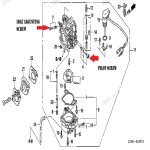Jim CuddyShark
New member
Hello Everyone,
I'm looking for a little help with a 2006 20hp remote control driven outboard I just purchased used. Here's what I can tell you:
- I am following the starting procedure outlined in the manual.
- The gas is 6 weeks old but has been treated with Sta-Bil as per instructions.
- The motor oil and gear oil are new.
- the battery is at least 5 years old.
- the water separating filter and the fuel filter found under the engine cover are both clean and working well.
- I have removed, cleaned, and checked the gap on both spark plugs (they looked clean).
here's the problem:
- the boat starts beautifully and idles well for 10-30 seconds before sputtering a few seconds and stalling.
- After stalling, it needs a few minutes before it will start again (and then stall again).
- if it idles long enough to let me get into gear and up to speed, it runs beautifully for as long as I want to be out until I pull back on the throttle and /or put it in neutral, at which point it sputters and stalls.
- I can't get the primer bulb very firm, no matter how many times I squeeze it.
Any thoughts or advice you may be able to provide would be very helpful. Thank you!
I'm looking for a little help with a 2006 20hp remote control driven outboard I just purchased used. Here's what I can tell you:
- I am following the starting procedure outlined in the manual.
- The gas is 6 weeks old but has been treated with Sta-Bil as per instructions.
- The motor oil and gear oil are new.
- the battery is at least 5 years old.
- the water separating filter and the fuel filter found under the engine cover are both clean and working well.
- I have removed, cleaned, and checked the gap on both spark plugs (they looked clean).
here's the problem:
- the boat starts beautifully and idles well for 10-30 seconds before sputtering a few seconds and stalling.
- After stalling, it needs a few minutes before it will start again (and then stall again).
- if it idles long enough to let me get into gear and up to speed, it runs beautifully for as long as I want to be out until I pull back on the throttle and /or put it in neutral, at which point it sputters and stalls.
- I can't get the primer bulb very firm, no matter how many times I squeeze it.
Any thoughts or advice you may be able to provide would be very helpful. Thank you!


